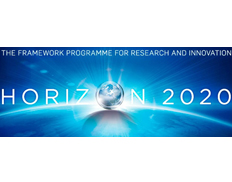Share
Print

Call updates:
25 June 2015 12:20
The Flash Call Info can be found under Call Documents tab
The number of proposals submitted for this topic: NMP-11-2015: 63
12 February 2015 08:58
Flash Call Info (2nd stage) can be found under [call documents] tab
Flash Call Info can be found under [call documents] tab
16 December 2014 07:53
An overview of the evaluation results (flash call info) is now available under the tab ‘Call documents’.
22 October 2014 15:58 The submission session is now available for: NMP-11-2015(RIA)
After the update to the Horizon 2020 Work Programme of 22 July 2014,
the following updates were made to the topics of this call:
27 May 2014 11:37
The Work Programme for Leadership in Enabling and Industrial Technologies,
“Nanotechnologies, Advanced Materials, Biotechnology and Advanced Manufacturing and Processing”
has been revised on 29 April 2014.
See the revised Work Programme in “Call documents” or click here.
23 May 2014 13:54
Important message on the Budget for the proposal :
In the administrative forms (Part A of the proposal) – Form "3. Budget for the Proposal" :
Column K (Requested grant) is NOT filled in automatically with the value of column J (Max. grant).
For first stage proposals, coordinators should indicate the total amount requested by the consortium, in column K.
02 May 2014 09:14
Clarification for NMP+B project proposers and evaluators on “Business Plan” and “Synergies with ESIF” - See "Call Documents"
02 April 2014 11:00
Important message on the Budget for the proposal :
In the administrative forms (Part A of the proposal) – Form "3. Budget for the Proposal" :
Column K (Requested grant) is NOT filled in automatically with the value of column J (Max. grant).
For first stage proposals, coordinators should indicate the total amount requested by the consortium, in column K.
02 April 2014 10:58
Important message on the Budget for the proposal :
In the administrative forms (Part A of the proposal) – Form "3. Budget for the Proposal" :
Column K (Requested grant) is NOT filled in automatically with the value of column J (Max. grant).
Coordinators should indicate the grant requested by each participant in Column (K).
12 March 2014 12:28
Please note that for this call, consortium partners are not required to be identified in the administrative form but must be mentioned in the Technical Annex. At a later stage, if and when invited for submitting an updated proposal under stage two, all consortium partners will have to be added in the administrative form.
10 March 2014 11:20
Clarification for NMP+B project proposers and evaluators on “Business Plan” and “Synergies with ESIF” - See "Additional Documents"
| Topic identifier: | NMP-11-2015 | ||
| Publication date: | 11 December 2013 | ||
| Types of action: | RIA Research and Innovation action | ||
| DeadlineModel: Opening date: |
two-stage 22 October 2014 |
Deadline: 2nd stage Deadline: |
26 March 2015 17:00:00 08 September 2015 17:00:00 |
| Time Zone : (Brussels time) | |||
Specific challenge: Promising pre-clinical nano-medicine proof-of-concepts have been developed for the therapy of cancer, but their translation into clinical therapies remains a major challenge. An important bottleneck is up-scaling under Good Manufacturing Practice (GMP) conditions for the production of the nanomedicines from the pre-clinical laboratory scale to the quantity needed for clinical testing.
Scope: The aim is to translate promising novel nano-technology enabled therapies for cancer with pre-clinical proof-of-concept, from a pre-clinical lab stage up to Phase I clinical testing. The project shall start from an established pre-clinical proof-of-concept, with relevant efficacy and toxicity data. The project shall be focused on the translation process, so that ultimately new effective therapies can be introduced to the European healthcare market. An important aspect is the development of a pilot line for scaling-up the production of the nanomedicines and the quality control, taking into account GMP and medical regulatory requirements. Projects may include the later stages of pre-clinical testing and Phase 1 clinical testing, but the latter is not a requirement. Nanopharmaceuticals may be manufactured with either a top-down or a bottom-up approach, using for example self-assembling technology. Applicants must describe, according to industrial criteria, how the various barriers for advancing their new therapy to clinical application will be overcome, including technical, IPR, competitive, commercial and regulatory criteria, with efficacy and toxicity. Attention must be paid to clinical trial design and the foreseen research and commercial path to market introduction has to be well outlined.
For this topic, proposals should include an outline of the initial exploitation and business plans, which will be developed further in the proposed project.
The research is to be implemented from TRL 4/5 and target TRL 6/7. Implemented as cross-KET activities.
The Commission considers that proposals requesting a contribution from the EU between EUR 6 and 9 million would allow this specific challenge to be addressed appropriately. Nonetheless, this does not preclude submission and selection of proposals requesting other amounts.
Expected impact:
Potential major improvement in clinical cancer therapy, thereby providing enhanced quality of life for patients (taking gender and other diversities into account).
Potential reduced direct and indirect healthcare costs linked to the disease and its treatment.
Accelerated introduction of new nanotechnology enabled cancer therapy, through robust manufacturing and quality control procedures for new nanotechnology enabled drugs.
Type of action: Research & Innovation Actions
